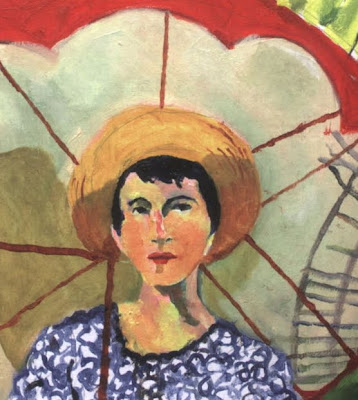The private family paintings of Derek Walcott
'At the gate, Petit Valley', circa 1980, watercolour.
They linger in the shadow of his accomplishments as a poet. These delicate watercolours and oil paintings that drape the walls of this small room. Many have come out today to listen to Walcott do a reading across the street from here, but few have ventured to the the principal's office of the University of the West Indies, St Augustine, Trinidad; to this small exhibition of private family paintings by a man whose reputation as a world-class poet bedazzles.
But the private family paintings here are far from all of that. They tell a different story; one rarely glimpsed and appreciated. For while Walcott--who at the date of this post celebrates his 80th birthday--may be remembered for his poetry, these pieces, I think, deserve to be rememembered for their quiet stylistic flair and their testimony to the talents of a man perhaps more read than understood. Undoubtedly he is more of a poet than a painter, but he is a painter of some merit still.
Witness the achievement that is his 2001 oil painting 'Country Fete'. Here is a rural scene of an old-fashioned fete in which nobody seems to be having any fun. Observe the poet's flair for detail: we have a drummer, decked in a red cap, looking more in pain than in rapture as he beats a rhythm, he has placed his hand on his heart, one of his fingernails is painted white. In the same picture, a violinist strumms out a tune, but is baleful; a woman in a red dress and a yellow hat is in the background, her face pale; her body oddly transfixed in the distance.
And then 'Petite Valley' (2000, watercolour), a kind of companion piece to the earlier 'At the Gate Petit Valley' (c. 1980, watercolour), demonstrates the power of the landscape under the right painter's brush. At first glance it appears to be a snapshot of a hill over-looking the northern Trinidad suburb that lends its name to the piece. But by being faithful to what he saw before him, Walcott captured something much more: a landscape in transition; being trammelled upon by unregulated development. Observe the large houses, not noted before in the 1980 painting, looking like scars on the hills. To the top left-hand corner are two forlorn cobos, almost penciled in, signalling something else amidst the green vegetation and houses. 'To Anna, Love Daddy' reads an inscription on the piece which is testimony to Walcott's not inconsiderable skills as a landscape artist.
The principal's office, UWI, St. Augustine, hosted private family paintings done by Derek Walcott.
The exhibition included paintings from the collections of Margaret Walcott, Anna Walcott-Hardy and Elizabeth Walcott-Hackshaw. Additionally, there was a piece by Walcott's father Warwick and another piece from the UWI library which had been donated to the library by Hester Ismond in memory of Dr Patricia Ismond, former senior lecturer at the university.
All underlined how the poet continues to produce paintings consistently, in between his major poetic works. For example, Walcott exhibited several pieces in New York in 2005, including 'Portrait of Claudia in Yellow Armchair'. For David Dabydeen's 2008 novel Molly and the Muslim Stick Walcott was persuaded to do the book-cover. The covers and dust jackets of Walcott's own books often feature his own work. Tiepolo's Hound, published in 2000, is a book-length poem that combines the stories of two painters—told in verse—with Walcott's own watercolor and oil paintings.
 Details of 'Portrait of Claudia in Yellow Armchair' (2005, oil on masonite) and 'Malo' (1993, water colour on paper) from Walcott's show at the New York June Kelly Gallery.
Details of 'Portrait of Claudia in Yellow Armchair' (2005, oil on masonite) and 'Malo' (1993, water colour on paper) from Walcott's show at the New York June Kelly Gallery. The paintings, then, are a part of Walcott's output which cannot be ignored. But while they are nowhere near as accomplished as his poetic works (the New York Times once famously declared that it's safe to say that Walcott will never win a Nobel Prize for visual art) we cannot ignore the value they add to our appreciaition of Walcott's artistic sensibilities. The reading across the road is packed, but there is enough room in this gallery for a small, but beautiful, gathering.





